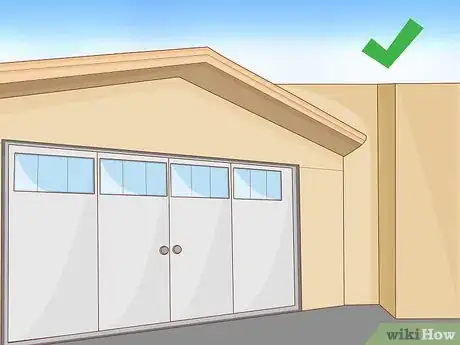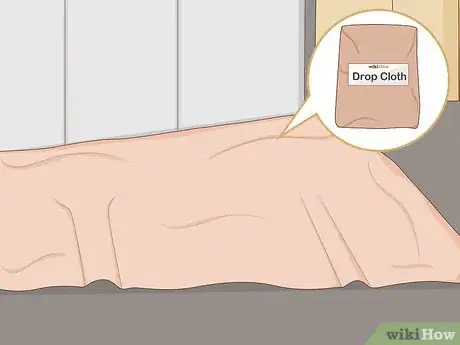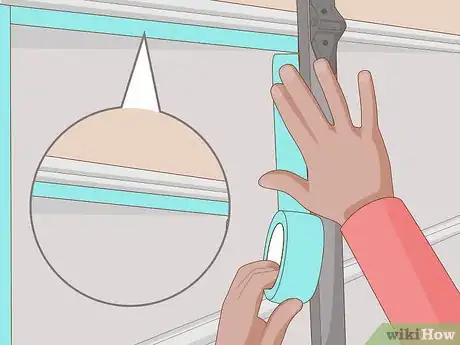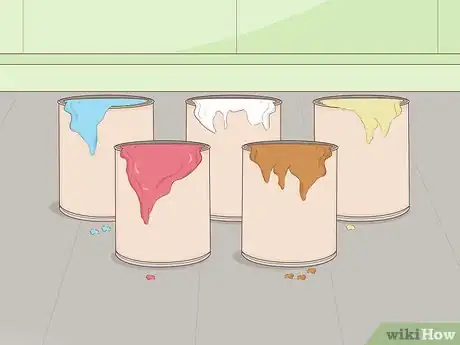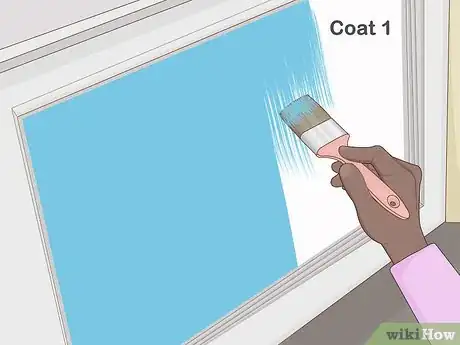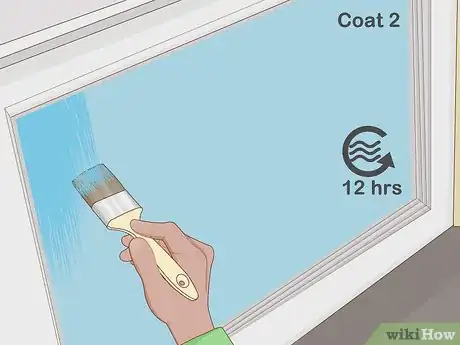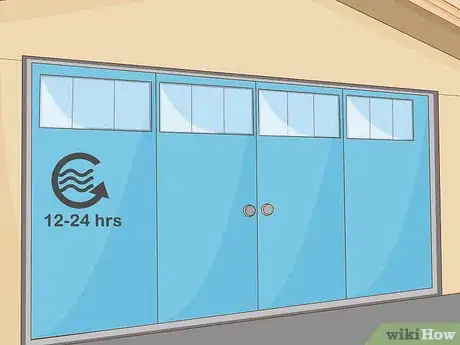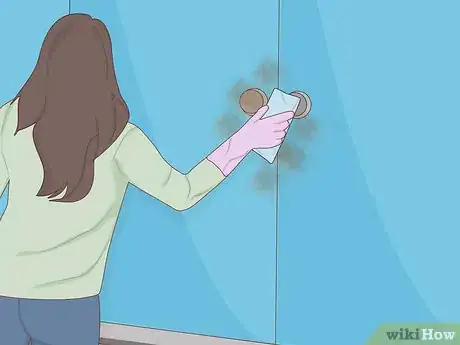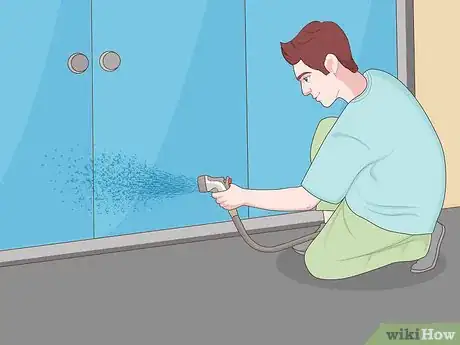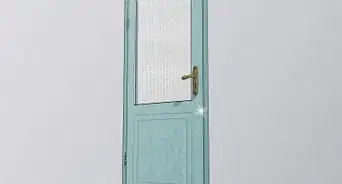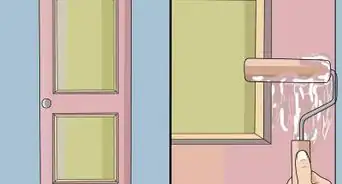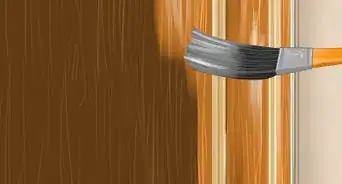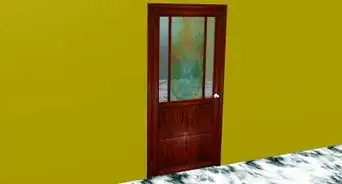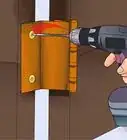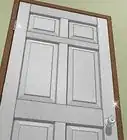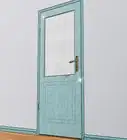This article was co-authored by Patrick Coye. Patrick Coye is the owner and operator of Patrick’s Painting & Home Improvement in Alexandria, Virginia. With over 15 years of experience in residential construction, Patrick specializes in painting, wallpaper removal/installation, drywall, staining decks and fences, and kitchen cabinetry painting. To date, Patrick and his team have painted over 2,000 houses and stained over 800 decks. Patrick's Company won a "Top Job" award from the American Painting contractor magazine in 2020.
There are 12 references cited in this article, which can be found at the bottom of the page.
wikiHow marks an article as reader-approved once it receives enough positive feedback. In this case, 84% of readers who voted found the article helpful, earning it our reader-approved status.
This article has been viewed 219,803 times.
Your garage door doesn’t just safeguard your vehicles and other belongings from the elements, it’s also a prominent part of your home’s exterior. That’s why, just like the rest of your house, it’s important to keep your garage door touched up. Renewing your garage door’s paint job couldn’t be easier—just line off the area you want to paint, pick a shade and roll on a smooth, even finish. A new coat of paint will defend against inclement weather conditions and provide an eye-catching focal point to make your home more attractive for years to come.
Steps
Preparing Your Garage Door
-
1Pick a day with mild, clear weather to paint. Climate conditions can have a big impact on the quality of exterior paint, especially when it’s fresh. Try to schedule your project for a stretch that’s not too hot, cold or humid. Be particularly wary of precipitation, as excess moisture can easily undo all of your hard work.[1]
- The next couple of days after you paint should also be clear in order to give new paint a chance to set properly.
- Weekends are an ideal time for painting a garage door, as you’ll have more time on your hands and won’t need to come and go as often.
-
2Give the garage door a thorough cleaning. Gently wipe away any caked-on dust, dirt or grime clinging to the outer surface of the door. Scrub from top to bottom, side-to-side, and don’t neglect the corners. A filthy garage door will be harder to paint, and may result in a sloppy, uneven finish.
- Though some professionals swear by certain specialty cleaning products, the best way to do this is simply to use a sponge or cloth soaked in soapy water.
- Rinse the door with a hose and blot it dry with a clean towel prior to painting. Never apply fresh paint to a wet surface.
Advertisement -
3Lay down a protective dropcloth. Before you begin painting, make sure the area beneath the garage door is covered on both sides. A dropcloth or plastic tarp will help prevent stains from dripping or splattering paint. It will also be useful for catching dirt and other debris that’s loosened from the door.[2]
- If you don’t have a dropcloth or tarp, an old blanket or a few sheets of overlapping newspaper will also do the trick.
-
4Tape off areas you don’t want painted. Use painter’s tape to cover any spots where paint might be spread accidentally, like the edges of the door where it meets house or surrounding brick or stucco. This can save you a lot of scouring and scraping later on should your painting project get a little messy.[3]
- Line up the tape with care and accuracy. Otherwise, you could end up with uneven edges.
- Look for wide rolls of tape to provide the maximum margin of error.
Applying a New Coat of Paint
-
1Select a shade you like. Shop around for paints in different colors that you think might suit your garage door. Be sure to only look at paints that are specially formulated for exterior use. For most garage doors, lighter shades like white, beige or pearl will work best because they won’t fade as much in the sunlight.[4]
- In general, it’s a good idea to match the color of the garage door to the color of the house itself. A contrasting trim color will create the look of depth around the door.[5]
- Stick to a color that’s similar to the one you’ve been using, or take the opportunity to explore new tones that change the overall aesthetic of your home.[6]
-
2Apply a primer to help the fresh paint stick. The primer will both provide a flat base for the paint and make for greater durability, allowing it to hold better over time. You’ll only need to use one thin coat of primer. Make sure the primer is dry to the touch before you attempt to paint over it.[7]
- Those who are planning on touching up their garage doors in the same shade can dispense with a separate coat of primer. It may be helpful, however, to purchase a paint that includes a built-in primer to ensure the color comes out the way it’s supposed to.
- Allow the primer to dry for at least 12 hours.
-
3Detail the smaller areas with a brush. Begin by painting the hard to reach recessed portions of the panels with a handheld brush. The narrow width and manual control offered by the brush will enable you to penetrate deeper into crevices and molded depressions. Work slowly and carefully, painting each of the inner panels one by one.[8]
- Look over the door to make sure you haven’t missed any thin or bare spots.
- Depending on the color and general condition of your garage door, you may need to use multiple coats to achieve a solid finish.
-
4Roll on the new coat of paint. After you’ve painted the recessed inner panels, use a wide paint roller to cover the broad outer surface of the door. Painting with a roller is quick and painless compared to manual brushing. A roller also guarantees a consistent finish, and won’t leave behind any visible strokes or seams. Paint with long, steady motions, overlapping the rough edges of each stripe.[9]
- For most basic paint jobs, a single coat of paint will usually be enough. If you're switching to a bolder shade or painting a lighter color over a darker one, it may be necessary to use multiple coats in order to get the color to show up.
- Let each coat dry for roughly 12 hours before applying additional coats.
- Set the door’s action to manual and raise or lower it as needed to paint a specific area. This will prevent the discomfort of being forced to crouch, stoop and stand repeatedly.[10]
- To avoid painting the door shut, run a utility knife blade along all of the seams in the door after you paint it. Or, if you prefer, you can paint the garage door in small sections.[11]
-
5Allow the paint to dry for 12-24 hours. Plan on allotting at least one full day for the paint to dry to the touch. During this time, it’s best to leave the door in a closed (down) position so that it can receive plenty of airflow. Resist the urge to touch the drying paint, and keep cars, bicycles, tools and toys at a safe distance.[12]
- Though the paint will usually harden to the touch in a matter of hours, it may take as long as a week for it to completely cure.
- It may be necessary to park your car outside while the garage door is drying.
Maintaining Your Garage Door
-
1Clean the garage door periodically. When the garage door starts to show dust or dirt, simply wet a sponge or washcloth with warm water and wipe it down. The flat, smooth paneling of most garage doors make them a breeze to clean, especially if you’ve used a semigloss latex or enamel paint.[13]
- When left untreated, dirt can eat away at a coat of paint, causing it to crack and fade.
- Avoid using cleaning products that contain harsh chemicals, as these can damage the paint.
-
2Inspect the door for cracks, chips or faded spots. Even if you’ve recently painted your garage door, harsh weather and other environmental factors can quickly do a number on it. Get in the habit of eyeing your garage door every so often and looking for areas that may need refreshing. Go over these areas with a little bit of fresh paint to keep the door in good shape from top to bottom.[14]
- Keep additional paint on hand for occasional touch ups and minor repairs.
-
3Repaint your garage door every 3-5 years. No matter how good a job you do, your garage door will inevitably need a new coat of paint. When you think it’s time, repeat the process to restore the door’s color and luster. Maintaining a protective layer of paint is key to extending the lifespan of your home’s garage door.[15]
- People who live in dry, temperate climates may be able to get away with going a little longer between paint jobs.
- Repainting your garage door should become a part of the routine maintenance and upkeep of your home.
Expert Q&A
Did you know you can get expert answers for this article?
Unlock expert answers by supporting wikiHow
-
QuestionAre there any mistakes to avoid when I'm painting the door?
 Patrick CoyePatrick Coye is the owner and operator of Patrick’s Painting & Home Improvement in Alexandria, Virginia. With over 15 years of experience in residential construction, Patrick specializes in painting, wallpaper removal/installation, drywall, staining decks and fences, and kitchen cabinetry painting. To date, Patrick and his team have painted over 2,000 houses and stained over 800 decks. Patrick's Company won a "Top Job" award from the American Painting contractor magazine in 2020.
Patrick CoyePatrick Coye is the owner and operator of Patrick’s Painting & Home Improvement in Alexandria, Virginia. With over 15 years of experience in residential construction, Patrick specializes in painting, wallpaper removal/installation, drywall, staining decks and fences, and kitchen cabinetry painting. To date, Patrick and his team have painted over 2,000 houses and stained over 800 decks. Patrick's Company won a "Top Job" award from the American Painting contractor magazine in 2020.
Painting Specialist
-
QuestionShould you paint the edges between the panels?
 Community AnswerYes, otherwise unpainted edges will be visible when you raise and lower the garage door. To make this easier, raise the door halfway and stop it. This will give you more room to get in between the hinged edges.
Community AnswerYes, otherwise unpainted edges will be visible when you raise and lower the garage door. To make this easier, raise the door halfway and stop it. This will give you more room to get in between the hinged edges. -
QuestionWhat type of paint is best?
 Community AnswerSemigloss paint, like acrylic latex and enamel, provide a smooth, even finish and are easy to wipe clean once they're fully dry.
Community AnswerSemigloss paint, like acrylic latex and enamel, provide a smooth, even finish and are easy to wipe clean once they're fully dry.
Things You'll Need
- Semigloss latex or enamel paint
- Paint roller and brush
- Primer
- Painter's tape
- Dropcloth or plastic tarp
- Sponge or washcloth
- Mild soap
- Water
References
- ↑ https://www.todayshomeowner.com/video/when-is-the-best-time-to-paint-the-outside-of-a-house/
- ↑ https://www.bobvila.com/articles/how-to-paint-a-garage-door/#.WL29AfkrLIU
- ↑ https://modernize.com/home-ideas/9677/how-to-repaint-garage-door
- ↑ http://www.garaga.com/blog/en/tips-choosing-right-garage-door-color/
- ↑ https://www.sensationalcolor.com/choosing-color-garage-doors/#.WL3S9PnyvIU
- ↑ http://www.bhg.com/home-improvement/garage/ideas-inspiration/garage-door-styles/
- ↑ https://www.bobvila.com/articles/how-to-paint-a-garage-door/#.WL29AfkrLIU
- ↑ http://www.behr.com/consumer/how-to/exterior/how-to-paint-a-garage-door
- ↑ https://www.youtube.com/watch?v=JzbczL9eiSo
- ↑ https://modernize.com/home-ideas/9677/how-to-repaint-garage-door
- ↑ Patrick Coye. Painting Specialist. Expert Interview. 22 July 2020.
- ↑ https://www.bobvila.com/articles/how-to-paint-a-garage-door/#.WL29AfkrLIU
- ↑ http://blog.raynor.com/blog-garage-door-cleaning
- ↑ http://www.garaga.com/blog/en/top-10-preventive-maintenance-tips-garage-door-owners/
- ↑ http://www.networx.com/article/how-often-should-you-paint-the-outside-o
About This Article
Before painting a garage door, clean it with a sponge and soapy water and dry it with a towel. Then, tape off any areas you don’t want the paint to touch, like the edge of the house. Next, apply 1 coat of primer to help the paint stick and allow it to dry for 12 hours. Once it’s dry, use a brush to paint smaller areas, corners, and edges, and use a wide paint roller to cover the large outer surface. If you need a second coat, allow the first one to dry for 12 hours. Finally, allow the paint to dry for 12 to 24 hours before using the door. To learn more about painting a garage door, like how to maintain a paint job, keep scrolling!
